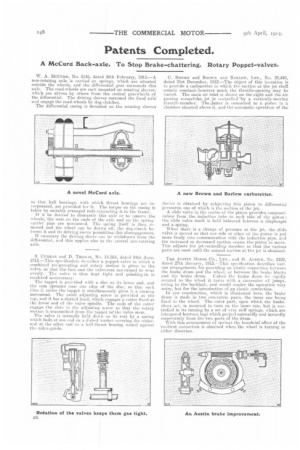Patents Completed.
Page 24

If you've noticed an error in this article please click here to report it so we can fix it.
A McCurd Back-axle. To Stop Brake-chattering. Rotary Poppet-valves.
W. A. ItIcerno, No. 5116, dated 28th February, 113.—A non-rotating /tele is tarried on springs, which are situated outside the wheels, and the differential gear surrounds this axle. The road-wheels are each mounted on rotating sleeves', which are driven by others from the central gearwheels of the differential. The driving sleeves surround the fixed axle and engage the road-wheels by dog-clutches. The differential easing is mounted OIL the rotating sleeves so that ball bearings, with which thrust bearings are incorporated, are provided for it. The torque on the casing is taken by suitably arranged rods connecting it to the frame. If it be desired to dismantle this axle or to remove the wheels, the nuts on the ends of the axle and cm the springcarrier pins are unscrewed. The spring itself is then, removed and the wheel can be drawn off, the dog-clutch between it and its driving sleeve permitting this disengagement. If necessary the driving sleeve can be withdrawn from the differential, and this applies also to the central non-rotating axle.
S. CURRAN and D. Tnosets, No. 14.584, dated 24th June, 1913.—This specification deecribes a peppet-valve in which a cembiried reciprocating and rotary motion is given to the valve, so that the face and the valve-seat are' caused to wear evenly. The valve is thus kept tight and grinding-in is rendered unnecessary.
The tappet is provided with a disc at its lower end, and the cam operates near one edge of the disc, so that each time it. raises the tappet it simultaneously gives it a turning movement. The usual adjusting screw is provided at the top, and it has a slotted head, whicic engages a cotter fixed at the lower end of the valve spindle. The ends of the cotter engage the slots in the adjusting screw so that the rotary motion is transmitted from the tappet to' the valve stem.
The valve is neernally held down on its seat by a spring which beds at one end on a dished washer covering the cotter, and at the other end on a ball-thrust bearing seated against the valee.goide. C. Betwils and BROWN AND BARLOW, LTD., No. 29,440, dated 21st December, 1912.—The object of this invention is to provide a carburetter in which the suction at the jet shall remain consteetehowever much the. throttle-opening may he varied. The main air-inlet is shown on theeright and the air passing acrossa thn. jet ,is controlled 'by a vertically-moving throttle-member. The 'latter is connected to a piston in 'a chamber situated above it, and the automatic operation of the device is obtained by subjecting this piston to differential pressures, one of which is the suetinn at, the jet. A slide valve in the centre of the piston provides communication from the induction tube to each side of the piston; the slide valve itself is held balanced between a diaphragm and a spring.
When there is a change of pressure at the jet-, the slide valve is moved so that one side or other of tiae piston is put more freely into communication with the induction pipe. and the inereaeed or decreased suction causes the piston to move. This adjusts the jet-controlling member so that the various parts are reset until the normal suction at, the jet is obtained.
THE AUSTIN MOTOR CO., LTD., and H. AUSTIN, No. 2109, dated 27th January, 1913.—This specification describes various arrangements for providing an elastic connection between the brake drum and the wheel, or between the brake block-s and the brake drum. Unless the brake drum be rigidly secured to the wheel it turns with a succession of jumps, owing to the backlash, and would render the operation very noisy, but for the introduction of an elastic connection.
In one construction, which is illustrated here, the brake drum is made in two concentric parts, the inner one being fixed to the wheel. The outer part, upon which the brakeshoes act, is mounted to turn on the inner one, but is controlled in its turning by a set of very stiff springs, which-are interposed between Jugs which project outwardly and inwardly respectively from the two parts of the drum. With this arrangement of eprines tile beneficial effect of the resilient connection is obtained when the wheel is turning in either direction.
























